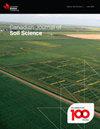Analytical and Experimental Evaluation of Two-Layered Unsaturated Sand Bearing Capacity
IF 1.5
4区 农林科学
Q4 SOIL SCIENCE
引用次数: 0
Abstract
Pavement design methods based on principles of unsaturated soil mechanics take into account high soil shear strength due to matric suction resulting in more economical design especially in long roads. In this study, the bearing capacity of two-layer unsaturated sand was investigated using both analytical and experimental methods. At first, using the limit equilibrium method an analytical formula was proposed to determine the bearing capacity of two-layer unsaturated sand in which linear suction profile was considered in soil layers. It should be considered that the constant matric suction distribution assumed by the previous researchers doesn’t show the real profile of matric suction within the soil, sometimes resulting in miscalculated unsaturated bearing capacity. Also, the bearing capacity of two-layer unsaturated poorly graded sand was investigated experimentally in different suctions by a special unsaturated chamber apparatus (UCA) designed for this purpose. The results show more than double increase of unsaturated soil bearing capacity with Sr=25% compared to saturated soil. The formation of failure wedges in all experiments was investigated by image processing. An acceptable agreement was obtained between the theoretical and experimental bearing capacity results.两层非饱和砂承载力的分析与实验评估
基于非饱和土壤力学原理的路面设计方法考虑到了由于母质吸力而导致的高土壤剪切强度,从而使设计更加经济,尤其是在长距离道路中。本研究采用分析和实验两种方法对双层非饱和砂土的承载力进行了研究。首先,利用极限平衡法提出了一个分析公式来确定双层非饱和砂的承载力,其中考虑了土层中的线性吸力剖面。需要考虑的是,以往研究人员假设的恒定母吸力分布并不能显示土壤内部母吸力的真实分布,有时会导致非饱和承载力计算错误。此外,还利用专门设计的非饱和室仪器(UCA),在不同吸力条件下对两层非饱和贫级配砂土的承载力进行了实验研究。结果表明,当 Sr=25% 时,非饱和土壤的承载力比饱和土壤增加了一倍多。所有实验中的破坏楔的形成都通过图像处理进行了研究。理论和实验承载力结果之间取得了可接受的一致。
本文章由计算机程序翻译,如有差异,请以英文原文为准。
求助全文
约1分钟内获得全文
求助全文
来源期刊

Canadian Journal of Soil Science
农林科学-土壤科学
CiteScore
2.90
自引率
11.80%
发文量
73
审稿时长
6.0 months
期刊介绍:
The Canadian Journal of Soil Science is an international peer-reviewed journal published in cooperation with the Canadian Society of Soil Science. The journal publishes original research on the use, management, structure and development of soils and draws from the disciplines of soil science, agrometeorology, ecology, agricultural engineering, environmental science, hydrology, forestry, geology, geography and climatology. Research is published in a number of topic sections including: agrometeorology; ecology, biological processes and plant interactions; composition and chemical processes; physical processes and interfaces; genesis, landscape processes and relationships; contamination and environmental stewardship; and management for agricultural, forestry and urban uses.
 求助内容:
求助内容: 应助结果提醒方式:
应助结果提醒方式:


